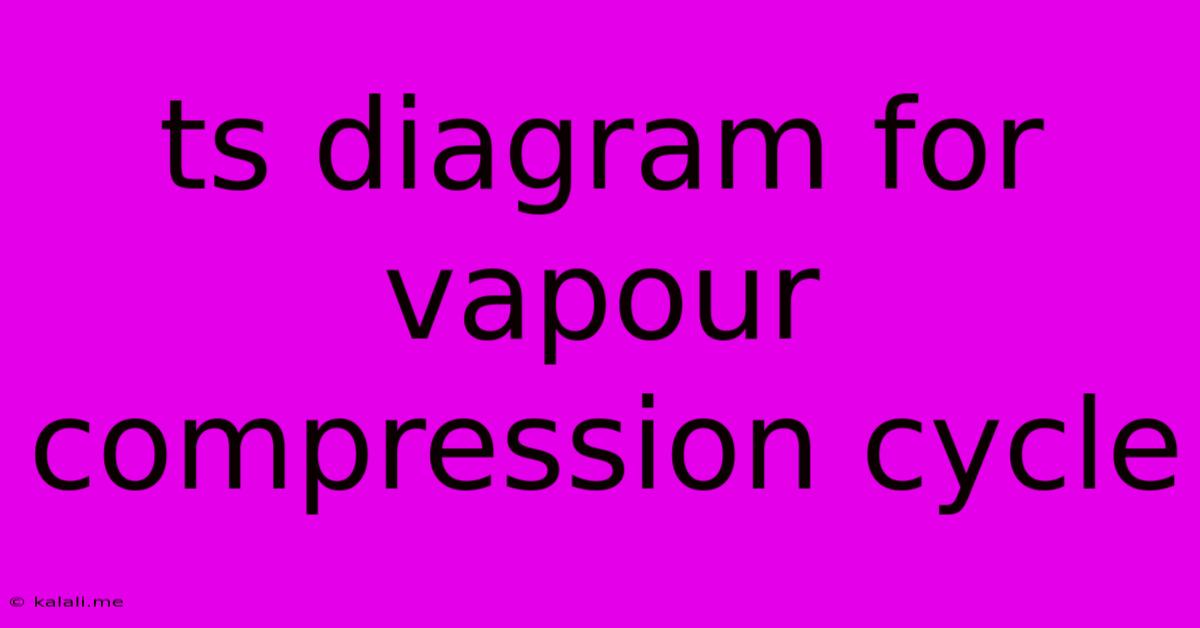Ts Diagram For Vapour Compression Cycle
Kalali
Jun 14, 2025 · 4 min read

Table of Contents
Understanding the T-s Diagram for the Vapor Compression Refrigeration Cycle
The vapor compression refrigeration cycle is a fundamental process used in countless applications, from air conditioning and refrigeration to industrial chilling. Understanding its thermodynamic behavior is crucial for optimizing performance and efficiency. A powerful tool for visualizing this behavior is the temperature-entropy (T-s) diagram. This article will provide a comprehensive explanation of the T-s diagram for the vapor compression cycle, detailing each stage and highlighting its significance in analyzing the cycle's performance. This guide will help you grasp the key thermodynamic properties and their implications.
What is a T-s Diagram?
A T-s diagram plots temperature (T) on the vertical axis and entropy (s) on the horizontal axis. It provides a visual representation of the thermodynamic processes involved in a cycle, allowing for easy identification of heat transfer and work interactions. Lines of constant pressure and specific volume are also often included, adding further detail to the analysis.
The Four Stages of the Vapor Compression Cycle on a T-s Diagram
The vapor compression cycle typically consists of four main processes, each represented by a distinct segment on the T-s diagram:
1. Isentropic Compression (1-2):
- The refrigerant enters the compressor as a low-pressure, low-temperature superheated vapor (state 1).
- The compressor increases the refrigerant's pressure isentropically (constant entropy), meaning no heat exchange occurs during compression. This is an idealized process; real compressors have some degree of inefficiency, resulting in a slightly higher entropy at state 2.
- On the T-s diagram, this is represented by a near-vertical line from state 1 to state 2, showing a significant increase in temperature and pressure with minimal entropy change.
2. Constant Pressure Condensation (2-3):
- The high-pressure, high-temperature superheated refrigerant enters the condenser.
- Here, it rejects heat to the surroundings at constant pressure, condensing into a saturated liquid (state 3). This is a crucial stage for heat removal from the system.
- On the T-s diagram, this is represented by a horizontal line from state 2 to state 3, demonstrating the decrease in entropy due to heat rejection.
3. Isenthalpic Expansion (3-4):
- The high-pressure saturated liquid passes through the expansion valve (or capillary tube).
- This is an isenthalpic process (constant enthalpy), where a significant pressure drop occurs without significant heat exchange.
- The expansion valve reduces the refrigerant's pressure to a low level. The refrigerant undergoes a phase change, becoming a low-pressure, low-temperature mixture of liquid and vapor (state 4). Note: This is not an isentropic process.
- On the T-s diagram, this is represented by a line sloping slightly downwards from state 3 to state 4, showcasing the pressure drop and the change in phase.
4. Constant Pressure Evaporation (4-1):
- The low-pressure, low-temperature refrigerant mixture enters the evaporator.
- Here, it absorbs heat from the refrigerated space at constant pressure, evaporating completely into a superheated vapor (state 1).
- On the T-s diagram, this is represented by a horizontal line from state 4 to state 1, indicating the increase in entropy due to heat absorption.
Analyzing Cycle Performance using the T-s Diagram:
The T-s diagram allows for quantitative analysis of various cycle parameters, including:
- Refrigeration Capacity: The area enclosed by the cycle represents the net refrigeration effect (heat absorbed in the evaporator). A larger area indicates higher refrigeration capacity.
- Work Input: The work done by the compressor can be determined from the area under the isentropic compression curve.
- Coefficient of Performance (COP): The COP is the ratio of refrigeration capacity to work input and is a key indicator of efficiency. A higher COP signifies better efficiency.
- Identifying Inefficiencies: Deviations from ideal isentropic compression and isenthalpic expansion can be observed and quantified on the diagram, helping to identify areas for improvement.
Conclusion:
The T-s diagram is an invaluable tool for understanding and analyzing the vapor compression refrigeration cycle. It allows for a clear visualization of the thermodynamic processes involved, facilitates the calculation of key performance indicators, and helps pinpoint potential inefficiencies. By mastering the interpretation of the T-s diagram, engineers and technicians can effectively optimize the design and operation of refrigeration and air conditioning systems.
Latest Posts
Latest Posts
-
Brass Is A Mixture Of What
Jun 14, 2025
-
Which Of The Following Are Pure Substances
Jun 14, 2025
-
What Is The Multiple Of 12
Jun 14, 2025
-
What Is The Difference Between Geology And Geography
Jun 14, 2025
-
Verbs That Start With The Letter E
Jun 14, 2025
Related Post
Thank you for visiting our website which covers about Ts Diagram For Vapour Compression Cycle . We hope the information provided has been useful to you. Feel free to contact us if you have any questions or need further assistance. See you next time and don't miss to bookmark.